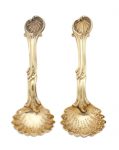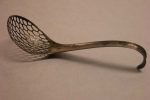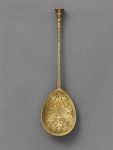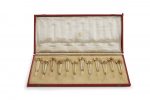Sugar Sifter Spoons can be found in a variety of styles. They can be found either as an item in a canteen or on its own. Handles can be plain, patterned or novelty and the bowls can be very intricate in their design. The Sugar Sifter Spoon was first introduced around 1770.
A William IV silver-gilt sugar sifter spoon and sauce ladle by Joseph & John Angell, London 1832 The scroll handles with shell terminals, shell form bowls, length 17cm. (2)
Sold for £ 375 inc. premium at Bonhams in 2014
SILVER SUGAR SIFTER SPOON BY NICOLAS GONTHIER OR NICOLAS GROS, PARIS, 1779 Net-shell model, engraved with a coat of arms surmounted by a crown of count, the perforated spoon of flowers and windings, punches: load, Jurande (letter P), master-goldsmith and discharge 97 gr. (3.15 oz.)
Sold for EUR 1,000 at Christies in 2012
French Pierced Sugar Sifter Spoon: French silver pierced sugar sifter spoon from the turn of the century. Marked H. G. for Henry Gabert. The hallmark indicated 800/1000 fineness. The spoon is decorated with alternating rows of gilt washed borders. The handle is decorated with a pronounced finial, a large convex shell shape tapering down to the spoon in flower and tendril patterns.
Sold for $100 at Converse Auctions in 2017
Japanese silver sugar sifter
Reference: The Metropolitan Museum of Art
Sugar Sifter Spoon English (London) 1786–87 Marked by Thomas Wallis II (first mark entered 1778)
The spoon, forged from one piece, has a deep round bowl pierced with crosses and garlands in a geometric pattern. The curving stem has an “Old English” end with a bright-cut medallion. Inscription Scratched on handle, “11147”. Markings On back of stem, maker’s mark TW (Grimwade 2975); lion passant; date letter l; sovereign’s head
Reference: Museum of Fine Arts Boston






